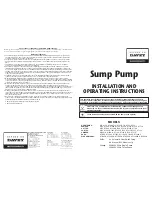
Outdoor Heat Pump
14 SEER R-410A High Efficiency Split System
User’s Information/Installation Instructions
These units have been designed and tested for capacity and efficiency in accordance with AHRI
Standards. Split System Heat Pump units are designed for use with a wide variety of fossil fuel
furnaces, electric furnaces, air handlers, and evaporator coil combinations.
These instructions are primarily intended to assist qualified individuals experienced in the proper
installation of heating and/or air conditioning appliances. Some local codes require licensed instal-
lation/service personnel for this type of equipment. Read all instructions carefully before starting
the installation.
IMPORTANT
Read this owner information to become familiar with the capabilities and use of your appliance.
Keep this with literature on other appliances where you have easy access to it in the future. If a
problem occurs, check the instructions and follow recommendations given. If these suggestions
don’t eliminate your problem, call your servicing contractor.
Heat Pump Principle of Operation
USER’S INFORMATION
5
4
1
2
3
6
5 4
3
2
1
6
SUMMER COOLING
1. Indoor air enters the air handler section.
2. Cold, heat-transfer section (indoor coil)
extracts heat from indoor air as refrigerant
evaporates from a liquid to a cold gas.
3. Refrigerant, drawn to heat pump and
compressed to a hot gas by heat pump,
carries the heat outdoors.
4. Hot, heat-transfer section (outdoor coil)
releases the heat as refrigerant condenses
from a gas to a liquid.
5. Heat pump (outdoor fan) discharges the
heat to outside air.
6. Refrigerant returns to indoor coil and
evaporates once again to absorb more
heat.
WINTER HEATING
1. Outdoor air enters heat pump.
2. Cold, heat-transfer section (outdoor coil)
extracts heat from outdoor air as refrigerant
evaporates from a liquid to a gas.
3. Refrigerant, compressed to a hot gas by
heat pump, carries the heat to the hot heat-
transfer section (indoor coil).
4. Hot, heat-transfer section (indoor coil)
releases the heat to indoor air as refrigerant
condenses from a gas to a liquid.
5. Air handler circulates the heat throughout
the home.
6. Refrigerant returns to outdoor coil and
evaporates once again to absorb more
heat.


































